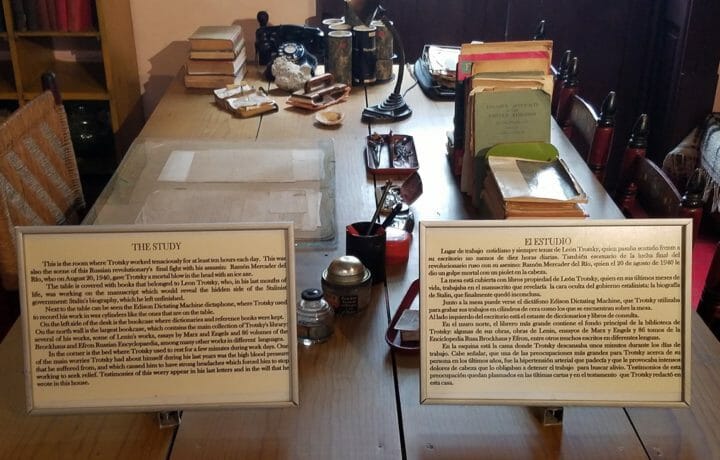Mexico City is a lovely place. It’s surrounded by mountains, the Mesoamerican history of Teotihuacan and its ancient pyramids. You can see clothing, art, and food from all the nation’s regions at Bazar Sabado in San Angel.
Mexico City is also home to an unexpected cultural jewel: the home where Communist luminary-turned-enemy of the state Leon Trotsky was assassinated. The Museo Casa de Leon Trotsky does an excellent job of laying the foundation of how Communism came to Russia, how WWI fanned the flames, and how eventually Communism became the dividing line between the whole world for almost an entire century. So who was Leon Trotsky and why did he die in exile thousands of miles from home?
Who Was Leon Trotsky?
Lev Davidovich Bronstein – better known by his pen name Leon Trotsky – was born on November 7, 1879. He was born into a well-to-do Jewish family in the Ukraine, at the time a part of the Russian Empire. As a teenager, instead of attending college, he left school to help start a labor union called the South Russian Workers’ Union. After his arrest and imprisonment with other union members in 1898, Trotsky met other revolutionaries in prison and was first introduced to the works and philosophy of Vladimir Lenin. From then on, Trotsky was bound inextricably with the fight for Communist rule in Russia.
After this episode, Trotsky was exiled to Siberia with his first wife in 1900. There, Trotsky studied economics and the philosophical underpinnings of the socialist movement and began writing in various newspapers. In 1902, Trotsky escaped Siberia and fled to England, where he continued to solidify himself as a philosophical leader in his movement.
After the 1905 uprising and massacre known as Bloody Sunday, Trotsky returned to Russia in secret to run the socialist newspaper The Soviet. A vocal opponent of the Czarist regime, employees of The Soviet were arrested in 1906 and Trotsky once again was exiled to Siberia. He later escaped once again to London and, in 1908, was writing for Pravda – the newspaper that would eventually become the official Soviet newspaper until the fall of the Soviet Union in 1991.
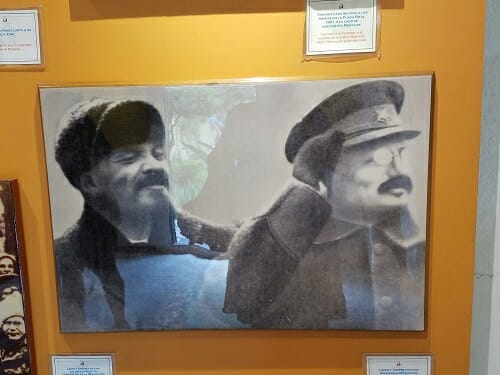
Trotsky would be second only to Lenin in his power and influence over the Bolshevik Revolution.
By this point, in spite of disagreements with Lenin, Trotsky had established himself as an important voice in his party. He was a key strategist in the Bolshevik uprisings of 1917, eventually paving the way to a Bolshevik-controlled Russian government.
How Did Trotsky End Up in Mexico City?
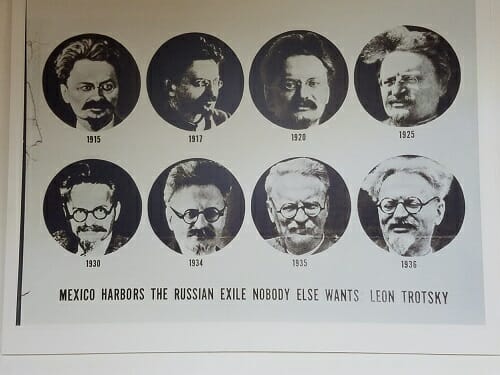
The international press recognized Trotsky as a political hot potato – governments did not want to invite political dissent or Stalin’s secret police into their backyards.
After the Bolsheviks seized control, Trotsky played essential roles in Lenin’s new government. He was at first the Commissar for Foreign Affairs, then became the head of the Red Army in the last few months of WWI. Perhaps most importantly, he squashed all uprisings against the new regime, paving the way for a Communist autocracy.
Upon the death of Vladimir Lenin in 1924, the popular and prominent Trotsky was the presumed heir to Lenin’s rule. However, he had a powerful enemy: Joseph Stalin. In the years prior to his death Lenin had groomed Trotsky to be his successor and Stalin fell increasingly out of his favor.
However, by this point Stalin had formed powerful political alliances, published misleading stories in the press, and managed to largely cut Trotsky out of any decision-making within the party. In the years following, Trotsky and his allies would mount an unsuccessful opposition to Stalin’s rule. But by 1927, Trotsky and his followers were removed from the Communist Party and the country itself. After decades fighting in exile for a new Russian government, he was now being expelled by the very government he had helped build.
Trotsky floated from Turkey, to France, and to Norway. These host nations heavily monitored and limited his political activities, fearing retribution from Stalin and workers’ uprisings in their own countries. By 1936, Trotsky and his wife were deported by the Norwegian government, eventually setting sail for Mexico. Trotsky was welcomed by the Mexican president and settled in the same neighborhood as the famous Mexican artists Frida Kahlo and her husband Diego Rivera.
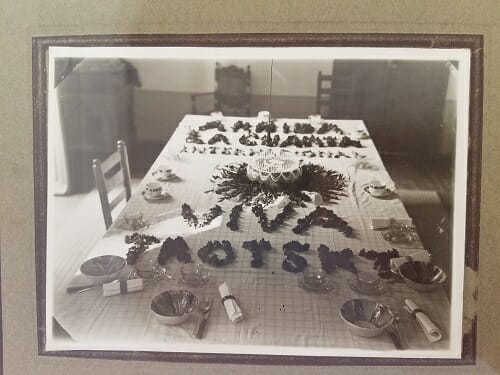
Trotsky is welcomed to Mexico with open arms.
Trotsky’s final years and assassination
Trotsky, along with his grandson and second wife, Natalia Sedova, moved into his last home in 1939. As Stalin conducted sham trials condemning Trotsky and his followers, it was clear that Stalin still saw Trotsky as a threat – even from thousands of miles away. Stalin’s secret police, the NKVD, had their eye on Trotsky even in Mexico City, waiting for the right moment to strike. Thanks to donations from the American Socialist Workers Party, Trotsky was able to buy and fortify his home and grounds. Visitors to the Trotsky House can see clearly where he had windows removed and walls lengthened in order to protect himself from Stalin’s assassins. The villa is built like a fortress, with three guard towers and a high stone wall surrounding it.
Despite Trotsky’s precautions and paranoia, on May 24, 1940, an NKDV agent and Mexican painter David Alfaro Siqueiros made an attempt on his life. Trotsky’s fourteen-year-old grandson was shot in the foot while hiding under his bed, but otherwise no one was injured. Visitors can still see bullet holes in the walls from this failed assassination attempt.

A stray bullet hole near the ceiling in one of the rooms in Trotsky’s house is evidence of the failed May 1940 assassination attempt at his home in Mexico City.
After this failed attempt, Trotsky said publicly that he knew Stalin would try to kill him again. He did not have to wait long. Despite intense security measures, on August 20, 1940, Trotsky was attacked by a trusted associate and undercover NKVD agent, Ramon Mercader.
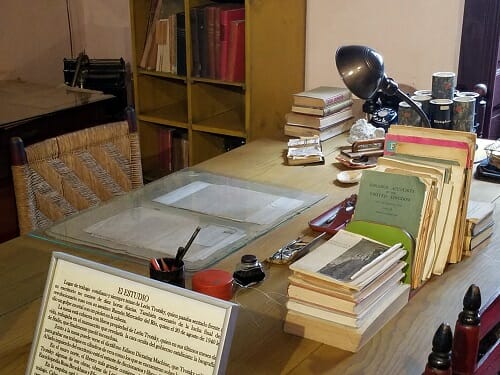
The desk where Leon Trotsky was struck by an assassin with an ice pick.
While Trotsky sat at his desk reading, Mercader snuck up on him from behind and struck him on the head with an ice pick. The blow did not immediately kill Trotsky, who struggled violently with Mercader as Trotsky’s guards rushed to his aid. Trotsky was brought to the hospital, but died several days later from his wounds.
Mercader was caught and served 20 years in a Mexican prison for the murder. While imprisoned, Stalin honored Mercader in absentia with the Order of Lenin for dispatching with his political foe. Upon his release from prison and return to the Soviet Union in 1961, he was declared a Hero of the Soviet Union – the highest honor given by the USSR. Today Mercader’s weapon can be seen on display at the International Spy Museum in Washington, D.C.
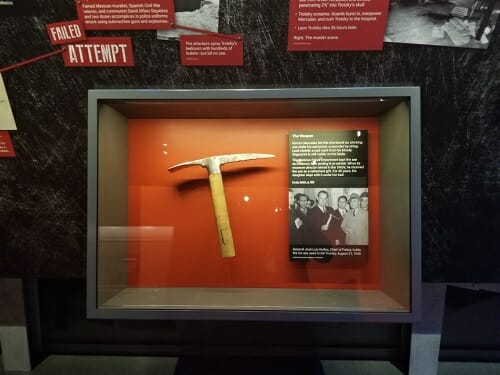
The ice pick that killed Leon Trotsky, on display at the International Spy Museum in Washington, D.C.
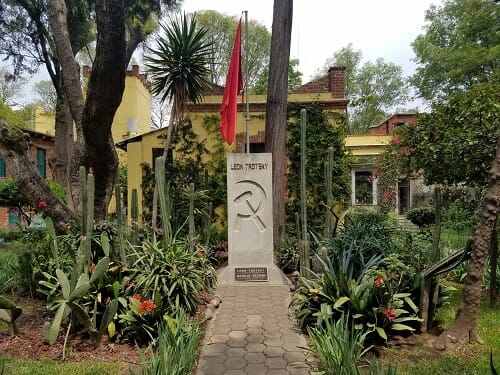
Trotsky’s final resting place in the backyard of his home in Mexico City.
Today, even decades after Trotsky’s death, Mexico City is still an unexpected battleground for espionage. There is a huge Huawei presence; cheap cell phones, wireless routers – all from a company tied to the Chinese government. In fact, all the power outlets in the Mexico City International airport are sponsored by the Chinese telecom giant. And remember, China and Russia have an intelligence-sharing agreement. So if you do visit CDMX, be careful where you plug in your phone or connect to wifi. Be cautiously paranoid. The Cold War isn’t really over.
